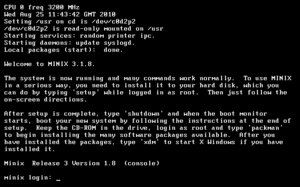MINIX
This article may have too many red links. (September 2011) |
MINIX is a Unix-like computer operating system based on a microkernel architecture. Andrew S. Tanenbaum wrote the operating system so it could be used for educational purposes; MINIX also helped Linus Torvalds design the Linux kernel. Its name comes from the words minimal and Unix.
 The MINIX 3.1.8 boot screen | |
| Developer | Andrew S. Tanenbaum |
|---|---|
| Written in | C |
| OS family | Unix-like |
| Working state | Current |
| Source model | Open source (originally COSS, now FOSS) |
| Latest release | 3.2.1 / February 21, 2013 |
| Repository | |
| Marketing target | Teaching (v1, v2) embedded systems (v3) |
| Available in | English |
| Platforms | PC, PC/AT, PS/2, Motorola 68000, SPARC, Atari ST, Commodore Amiga, Macintosh, SPARCstation, Intel 386, PC compatibles, NS32532, ARM and INMOS transputer |
| Kernel type | Microkernel |
| Default user interface | Command line interface (ash) |
| License | Originally proprietary, BSD license since 2000 |
| Official website | www |
Released under the BSD license, MINIX is free and open source.
History
changeAndrew S. Tanenbaum created MINIX at Vrije Universiteit in Amsterdam.
MINIX 3
changeMINIX 3 was announced to the public on 24 October 2005 by Andrew Tanenbaum during his speech on top of the ACM Symposium Operating System Principles conference. MINIX 3 currently supports only IA-32 architecture PC systems. It has a Live CD format that lets it be used on a computer without installing it. Version 3.1.2 was released 8 May 2006. It contains X11, emacs, vi, cc, gcc, perl, python, ash, bash, zsh, ftp, ssh, telnet, pine, and over 400 other common UNIX programs. With the addition of X11, this version starts the change from a Text-Only System.
MINIX and Linux
changeThe design principles Tanenbaum applied to MINIX had influenced the design decisions Linus Torvalds applied in the creation of the Linux kernel. Torvalds used and appreciated MINIX, but his design was different from the MINIX architecture in significant ways, most notably by employing a monolithic kernel instead of a microkernel. This was famously disapproved by Tanenbaum in the Tanenbaum-Torvalds debate. (Tanenbaum explained again his rationale for using a microkernel in May 2006.)
Linux being copied from MINIX
changeIn May 2004 Kenneth Brown of the Alexis de Tocqueville Institution raised the accusation [1] that major parts of the Linux kernel had been copied from MINIX, in a book called Samizdat.
These accusations were rejected by Andrew Tanenbaum, who said that Kenneth Brown was very wrong and published a long rebuttal on his personal website.[2][3]
Licensing
changeIts licensing fee was very small ($69) compared to the ones of other operating systems. Although Tanenbaum wished for MINIX to be as easily available to students, his publisher would not allow it.
When free/open source Unix-like operating systems such as Linux became available in the early 1990s, many volunteer software developers stopped using MINIX for Linux. In April 2000, MINIX became free/open source software under a permissive free software licence,[4] but by this time other operating systems were much better, and it was mostly used as an operating system for students and hobbyists.
Related pages
changeReferences
change- ↑ Alexis de Tocqueville Institution/Kenneth Brown, 'Samizdat's critics... Brown replies', http://www.adti.net/samizdat/brown.reply.june.04.html Archived 2010-12-29 at the Wayback Machine
- ↑ Tanenbaum, Andrew S. 'Some Notes on the "Who wrote Linux" Kerfuffle', http://www.cs.vu.nl/~ast/brown/
- ↑ Tanenbaum, Andrew S. 'MINIX 3 FAQ', http://www.MINIX3.org/doc/faq.html#legal Archived 2005-10-26 at the Wayback Machine
- ↑ "The Minix licence". Archived from the original on 2007-06-13. Retrieved 2008-07-07.
Other websites
change- Official MINIX 3 Operating System site Archived 2012-06-21 at the Wayback Machine
- The MINIX category Archived 2005-08-31 at the Wayback Machine at the Open Directory Project
- History of MINIX from Andrew Tanenbaum